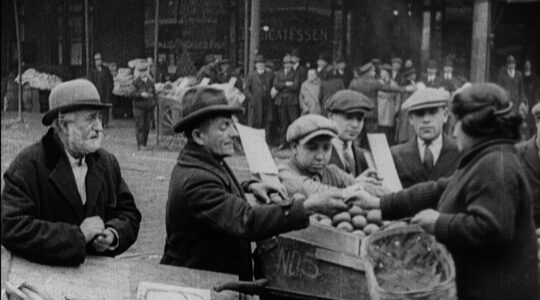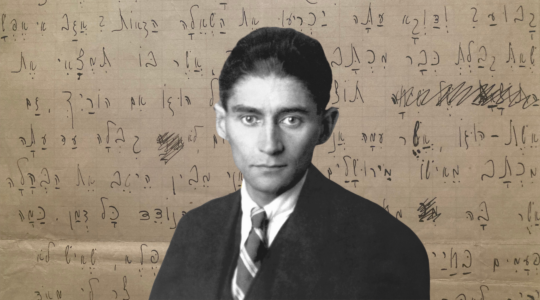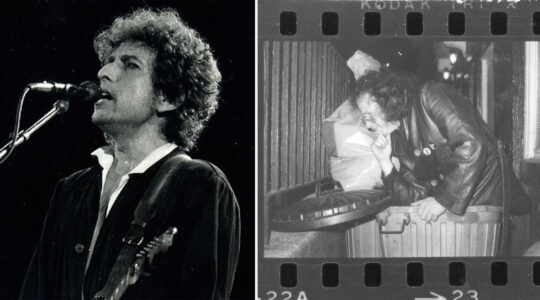American-Jewish pastoral: Howard Megdal’s new “The Baseball Talmud,”
American-Jewish pastoral: Howard Megdal’s new “The Baseball Talmud,”
by Jonathan Mark
Associate Editor
Earl Weaver used to say, baseball isn’t football: “We do this every day.” Judaism, too. We do this every day, short bursts of action interspersed with lots of chewing, scratching and sweet memories; guys sneaking catnaps in dugouts or pews, waking up with a start, quick with an opinion without missing a beat when talk turns to strategy or ancient summers. What others call boring — the rain delays, endless Shabbat afternoons in August — are what the rest of us know as the best time to tell the old stories.
As minor leaguer Crash Davis said in “Bull Durham,” “I believe in the soul … the hanging curve ball, high fiber, good scotch … long, slow, deep, soft…”
Well, it’s about the soul,
anyway, and in plenty of shuls, the good scotch, too.
The season has opened. Tell the stories. Keep in mind George Will’s maxim, that like Talmud trivia, “baseball trivia is an oxymoron.”
“The Baseball Talmud,” by Howard Megdal, new from HarperCollins, offers both a whimsical and Bill Jamesian position-by-position ranking, and quirk, of every Jewish ballplayer, all 159 since the dawn of time — except Josh Whitesell, who pinch-homered for the Diamondbacks last September after the book went to bed.
There was Happy Foreman, says Megdal, “the last of the Happys,” a southpaw reliever in the 1920s who was the last of 16 major leaguers nicknamed Happy. There have been four Sleepys, 85 Docs, four Moxies (including our Moxie Manuel) and 22 Heinies, including our Heinie Scheer (Athletics, 1922-23).
You may remember a journeyman Mets catcher, of whom a snarky Casey Stengel said, “I got a kid, Greg Goosen, he’s 19 years old and in 10 years he’s got a chance to be 29.”
Now that the Jewish Goose is in his 60s “he got a chance” to act, with bit parts in Hollywood when not working as the stand-in for Gene Hackman in five movies, including “Unforgiven” and “Get Shorty.”
When it rains, tell the kids about Mose Solomon, “the Rabbi of Swat,” of whom the Sporting News ran a headline in 1923, “Dick Kinsella [Giants scout] Finds That $100,000 Jew.” He played for the Wheat Shockers — the Wheat Shockers! — in Kansas, in the third-lowest rung of the minors. A slugger, he could punch, too. The Sporting News said the word quickly spread through the Western League, “lay off the big Jew.” He was gone after three hits in the majors.
Megdal comes up with the kind of gems that Topps put on the back of bubble gum cards. Lou Limmer (Athletics, 1951, 1954) is the only major leaguer to become president of a shul, the Castle Hill Community Jewish Center in the Bronx.
Pitcher Justin Wayne (Marlins, 2003-04) went to Barack Obama’s alma mater, Punahou High School in Hawaii.
Pitcher Moe Savaransky (Reds, 1954), who went to Ohio State, writes Megdal, “could have been a classmate of Ronald Patimkin, the older brother of Brenda Potemkin in Philip Roth’s ‘Goodbye, Columbus.’”
Bob Tufts (Giants, 1981, Royals 1982-83) says he had a relative “who was the first woman tried and convicted of witchcraft,” in Essex County, Mass., 1680.
Whatever happened to Adam Greenberg (Cubs, 2005)? He was knocked out by a fastball to the skull on the first pitch he ever saw and couldn’t even run to first base. Megdal discovered that Greenberg hit .271 last year for the Arkansas Travelers.
According to the “Baseball Encyclopedia,” only one player, left fielder Albert Cohen (Dodgers 1931-32, Phillies, 1934), was nicknamed Alta. According to Martin Abramowitz, creator of the complete Jewish baseball card set (at www.jewishmajorleaguers.org, over 15,000 sold), Cohen’s father gave him the name Alta (Yiddish for “old”) as the traditional Jewish trick to fool the Angel of Death during the 1918 flu epidemic. In the majors, Alta’s teammates must have figured him for a Benjamin Button trajectory, calling old Alta “Schoolboy,” says Baseball-Reference.com
Baseball-Reference, the online encyclopedia, honors the old nicknames, such as Barney Pelty, “the Yiddish Curver.” The St. Louis Browns right-hander (1903-12), says Abramowitz, had the lowest earned run average of any Jewish pitcher, 2.63. Sandy Koufax finished at 2.76.
Abramowitz, of Newton, Mass., founder of Jewish Major Leaguers, Inc., the historical society that has a new 50-card set honoring Jewish record holders, says, overall, Jewish players have done well, with a slightly higher batting average, home run percentage, won-lost percentage, and lower ERA than non-Jews. “The only stat to which Jews do not compare favorably,” says Abramowitz, “is stolen bases.”
Ryan Braun, the current Brewers slugger, and the first major leaguer with an Israeli father, has shown such a disproportionate use of force at the plate that Megdal figures he’s on pace to have more homers than Hank Greenberg by age 32.
Megdal, who writes about baseball for The Observer, Rotoworld (a fantasy baseball site, but aren’t they all), and SNY, the cable station, finds himself reflective when imagining the loneliness of Jewish players in minor league towns in the old South, such as Jesse Baker (Senators, 1919) who played in the Piedmont League less than a decade after a lynch mob in Georgia kidnapped and hung a Jewish businessman, Leo Frank, from a tree.
Journalism was different then. Megdal uncovered this gem: The Sporting News said of Andy Cohen (Giants, 1926, 28-29) after “the young Hebrew” was called up to the Polo Grounds, “Oy Gevald! … the fact remains that the Jewish boy is in captivity and that’s something when it is considered Israel’s children are the real dodos of the baseball woods.”
Cohen, added The Sporting News, “has all the natural characteristics (physically) of his race — thick, dark hair, dark skin and keen mentality.”
His brother, Syd Cohen (Senators 1934, 36-37) opted for assimilation, with a twist. He ran off to play in the Mexican League, changing his name from Syd Cohen to Pablo Garcia.
So much for the Giants plan to sell “ice cream Cohens” at the Polo Grounds.
There’ll be no frozen Cohens in the new Yankee Stadium and Citi Field, but once again there’ll be glatt kosher vendors: Ouri Caterers, from Brooklyn, selling in the Bronx, and Kosher Sports, from Engelwood, N.J., selling in Flushing.
Ouri couldn’t tell us their YS locations, but Jonathan Katz, 33, owner of Kosher Sports, says he’ll have four stands at Citi Field: Sections 115 and 130 in the lower deck, and Sections 401 and 428 in the upper deck.
Humphrey Bogart used to say, “a hot dog at the ballpark beats steak at the Ritz,” but Katz, like many observant Jews, remembers his childhood frustration at being unable to Bogart a dog. Inspired, Katz, 33, went into the stadium business, becoming the kosher vendor for the Devils, Orioles, Ravens, Eagles, Nationals and Cyclones. And he’s doing something remarkable. Saying, “It’s already expensive enough to go a ball game,” he’ll be selling kosher ballpark food at exactly the same price as the non-kosher food at Citi Field, and lower than similar items at Yankee Stadium.
Aside from hot dogs ($4.75) and sweet Italian sausages with onions and peppers ($7.25), Kosher Sports will be offering knishes, pretzels, peanuts, beer, water and soda.
Mincha or Maariv at a Mets game will be in the middle of the seventh inning. Like Earl Weaver said, “We do this every day.”
The New York Jewish Week brings you the stories behind the headlines, keeping you connected to Jewish life in New York. Help sustain the reporting you trust by donating today.




